Archived Mold Remediation Blog Posts
Spotting the Signs of a Potential Mold Problem
6/26/2023 (Permalink)
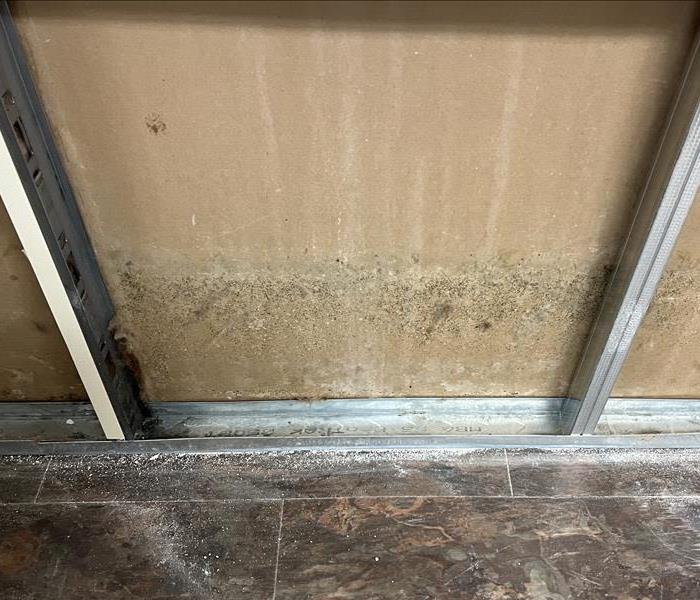 This is a great example of how microbial growth can form on the back of drywall and other hidden areas!
This is a great example of how microbial growth can form on the back of drywall and other hidden areas!
Maintaining a healthy living or working environment requires a keen awareness of several factors, one of which is the potential presence of mold. This microscopic organism thrives in damp settings that are all too common in Eastern Carolina, which can have detrimental effects on indoor air quality. However, mold frequently grows in hidden spots, making it somewhat challenging to identify. The following are some prevalent signs that might indicate a mold problem in your property.
Visible Signs of Mold Growth
The most blatant indication of a mold problem is visible mold growth. Mold takes on various colors - black, green, or white patches on surfaces are common appearances. It often presents as a stain or smudge, blemishing walls, ceilings, or floors. However, remember that visible mold growth is just the tip of the iceberg. If you spot it on the surface, it's highly likely there's a more extensive infestation hidden away. It's crucial to remember that not all mold is harmful, but you should always consult with a professional if you discover mold growth.
Persistent Musty Odors
Mold produces a characteristic smell. If you notice a persistent musty or earthy odor, especially in damp areas such as basements, bathrooms, or kitchens, it could be a sign of concealed mold growth. Remember that your sense of smell might be the first to pick up on mold growth that your eyes can't see.
Allergic Symptoms and Health Impact
Mold exposure can potentially lead to health effects. If your allergic symptoms worsen in your home or a specific building and improve when you're away, this could point to indoor mold growth. Common signs of mold exposure can include sneezing, runny or stuffy nose, itchy or red eyes, and skin rashes. Individuals with asthma might experience more frequent or more severe attacks.
Water Leaks, Flooding, or Past Water Damage
Areas that have experienced water leaks, flooding, or other forms of water damage are prime breeding grounds for mold growth. Damp materials or areas provide the moisture that mold spores need to grow and reproduce. If your property has a history of water-related issues, be vigilant about potential mold growth.
Condensation and Humidity Levels
Excessive condensation on your windows, walls, or pipes can indicate high humidity levels, which can foster mold growth. Condensation can provide the ideal conditions for mold spores to thrive, especially when coupled with inadequate ventilation or a lack of direct sunlight.
Recognizing these signs is just the first step. If you suspect a mold problem, it's crucial to act quickly. Ignoring the signs won't make the mold disappear; it merely gives it more time to proliferate and potentially lead to more substantial problems. SERVPRO® of Bath has trained professionals equipped with advanced tools and industry knowledge to help you navigate the mold remediation process effectively. We adhere to the highest industry standards and work diligently to help you maintain a clean, healthy environment.
If you suspect mold, a professional assessment is always the wisest course of action. Give us a call at 252-923-0213!
A Layperson's Guide to Types of Mold Growth Found in Homes
3/24/2022 (Permalink)
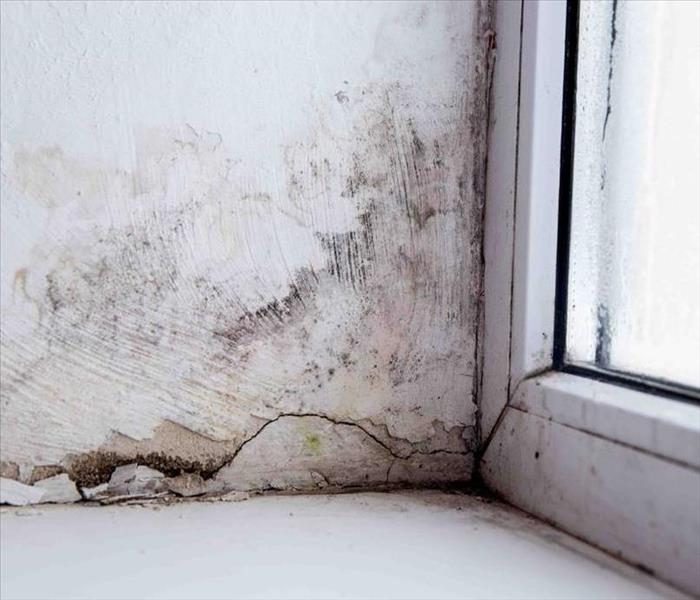 Learn More about the different Types of Mold Growth by Considering These Tips.
Learn More about the different Types of Mold Growth by Considering These Tips.
Discovering mold growth in your home is a disturbing situation. Besides its funky smell and appearance, mold can cause costly damage that needs repair. If you're lucky, you will never have to deal with any of the following types of spores known to infest residential quarters. If one of them does, a mold remediation specialist can help you get rid of it.
What Are Reasons You Should Hire a Professional To Get Rid of Mold Growth?
Hiring a professional provides you with:
- Rapid response
- Safety assurance
- Easier insurance claims
Have a specialist complete the cleanup process for superior results.
What Is Stachybotyrus Chartarum?
More commonly known as black mold, this fungal invader is notorious. It creates toxic compounds known as mycotoxins. Because of this, homeowners must act quickly to eliminate it and preserve their family's safety. You can find it haunting locales such as ducts and air conditioning pipes. Its distinct, musty odor is a solid giveaway.
What Is Penicillium?
Particular variants of this mold species play a vital role in creating antibiotics and cheese. The kind that's inside your insulation and furniture is less helpful. Its ability to spread rapidly makes it especially pernicious.
What Is Alternaria?
This type of mold spawns both inside and outside. Because it often appears in damp areas, you may find it lurking in the shower or sink. The difficulty of repairing water damage gets compounded when this fungal variant appears.
What Is Aureobasidium?
Be on the lookout for spotty black and pink growths. If you spy any, you probably have aureobasidium. It often attaches to wooden furniture, but it can also be found on walls, whether painted or wallpapered.
What Is Fusarium?
Cold, wet areas are ideal breeding grounds for this type of mold. Keep your eyes peeled for it when colder conditions take hold in Bath, NC. You can find it living within carpets and other types of fabrics.
What Is Cladosporium?
High humidity can contribute to this form of mold, which loves to spread in warm areas as much as cold ones. Look for it inside wooden cabinets, within rugs, and underneath floorboards.
What Is Aspergillus?
Here's another class of indoor mold that requires caution. Anyone within its vicinity should wear a respirator to prevent the possibility of inhaling spores.
What Is Serpula Lacrymans?
Does the mold in your home have a yellow hue? If so, you may have this type. Most commonly, it flourishes outside. That said, it also attaches to wooden surfaces indoors. As it progresses, so does dry rot, which often requires extensive renovations.
What Is Ulocladium?
Homes that have experienced flooding are especially susceptible to this category of mold. Ulocladium grows both on the insides and outsides of buildings. It has a nasty way of attacking floors and walls that makes cleansing efforts particularly cumbersome.
No matter what class of fungal assailant presents itself within your home, destroy it posthaste. Failure to handle the issue with urgency allows it to spread, subsequently compounding the matter and increasing clean-up costs. Start by figuring out what classification of mold growth has taken over your abode. This chunk of information will help cleaners approach the sterilization process with maximum efficiency and effectiveness.
Using an Indoor Environmental Specialist To Determine the Presence of Mold
9/20/2021 (Permalink)
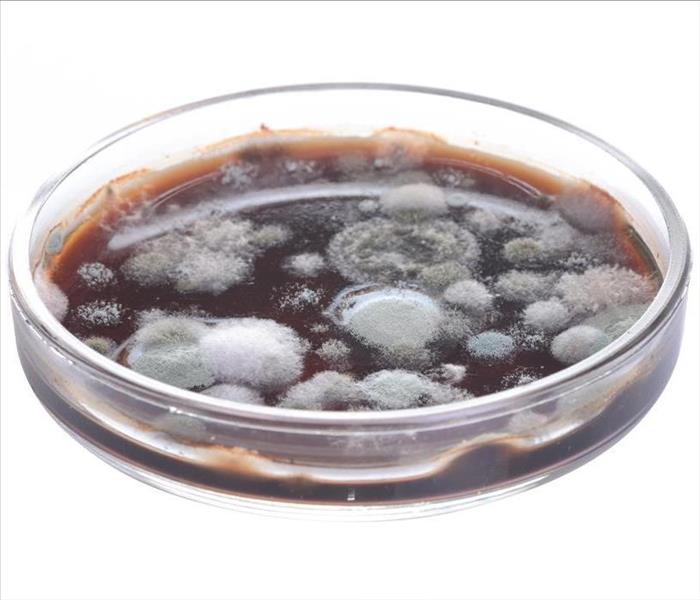 Perform a mold test will determine which type of mold is and the process of cleaning.
Perform a mold test will determine which type of mold is and the process of cleaning.
When you walk into your building, do you smell something musky or damp? That smell could be mold, but it is challenging to know for certain if you cannot find the source. An indoor environmental specialist, like those employed at mold remediations companies in Washington, NC, can help you find the source of the smell and identify whether the problem is mold. These professionals do these in one of a few ways, including:
- Taking a physical sample of the growth
- Performing an air reading for mold spores
- Taking a sample of the area
Each method will provide varying results, especially of any level of certainty. However, the most effective method to test for mold is taking a sample of the growth and sending it to an off-site lab. Off-site testing is unnecessary for every situation, but if the mold looks suspicious or toxic, an involved mold test will provide the best analysis.
Why Perform a Test?
A test to determine the species of mold is sometimes necessary to determine the correct cleaning methods. There is little need for additional testing or protection for typical mold growth because it is relatively safe and will not harm a person when inhaled.
However, as any indoor environmental specialist will explain, some mold infestations require safety precautions to protect the workers and the property. Toxic black mold, for instance, is a substance with several state regulations regarding proper collection, removal, and disposal.
Testing the substance is just a way to ensure safety and maintain state and health department regulations. Beyond keeping everyone safe, a test can help determine the size and spread of the infestation. For widespread growth, a remediation specialist will want to seal off the main area.
Additionally, the primary reason for performing a mold test is when there are no visible signs of mold. An air quality test can help a remediation professional determine if there is mold in the area. It is best to go with a professional for such a test rather than purchasing a test kit at a store because commercially available kits are not the most accurate and can be challenging to interpret.
Mold spores are always present. Therefore, it is possible for purchased mold kits to provide a false positive for an infestation. An indoor environmental professional can help you determine when the mold levels require remediation.
Mold Remediation
If your building requires mold remediation, do not do it yourself. Hire a remediation service. These companies are aware of all the safety and removal protocols for mold, meaning you do not risk any fines from environmental agencies. Additionally, your insurance provider might require professional remediation to ensure the problem is resolved; failing to comply could result in the elimination of your policy.
Any time you believe you have a mold problem but cannot find any visible clues, you should contact an indoor environmental specialist to test the property's air quality. If mold is found, consider hiring a professional for removal to protect your building and business. DIY methods are usually never adequate for effective mold removal.
Understanding the Resurgence of a Mold Infestation
6/28/2021 (Permalink)
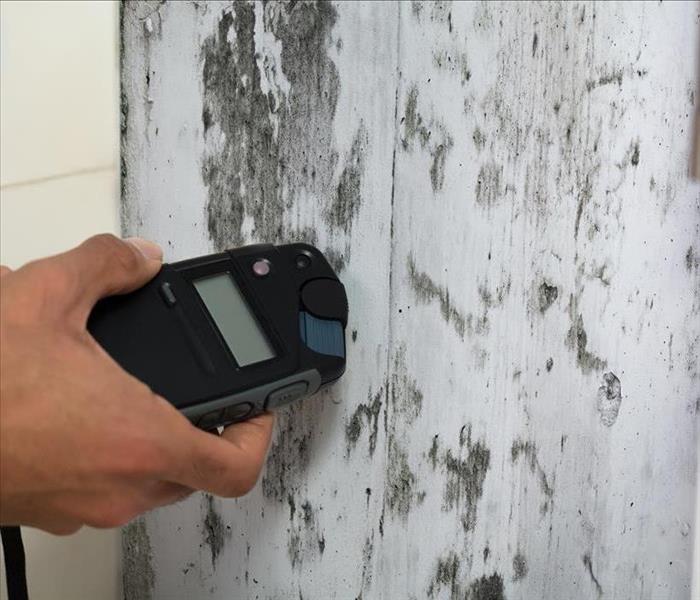 Mold growth on residential home.
Mold growth on residential home.
As a homeowner, there are two words you never want to hear: black mold. Unfortunately, the fear of toxic mold can often lead to homeowners attempting DIY removal techniques that do not work.
Mold is not mildew, and that is essential to know. Mildew is a surface growth, meaning you can typically eliminate it with surface cleaners. Mold, however, establishes deep within porous materials. If you attempted a DIY removal without the help of a licensed mold remediation service in Washington, NC, there could be several reasons the problem keeps resurfacing.
3 Reasons of a Mold Infestation Resurgence
1. You Did Not Resolve an Underlying Water Issue
Mold cleanup is about more than removing the problem fungus. You must get to the root cause. Why did mold spores settle where they did? In most situations, mold is the result of a water leak. If you do not resolve the underlying water issue, mold will return. Sometimes, a homeowner fixes a minor water problem, not realizing there is a more significant issue somewhere else.
2. You Did Not Remove the Entire Infestation
Black mold, or any mold, accumulates inside porous materials. When you are trying to remove the growth, you need to excise it in its entirety. If you leave even a small portion of mold in the area, the cluster will repopulate, re-establishing the infestation. If you are not confident in removing the problem, contact a licensed professional, which is the preferred method and approach to mold removal.
3. You Did Not Contain Mold Spread
When professionals remove mold, they do their best to control the spread and release of mold spores that can repopulate an infestation site. These technicians will spray down the affected area, weighing down spores, and they will seal contaminated spaces to ensure spores have nowhere to go.
Black mold or mold, in general, is not something homeowners like to think about. However, if you suspect you have a mold problem, it is crucial to take accurate precautions and eliminate the growth the first time around.
3 Reasons You Might Find Mold in Your House
3/22/2021 (Permalink)
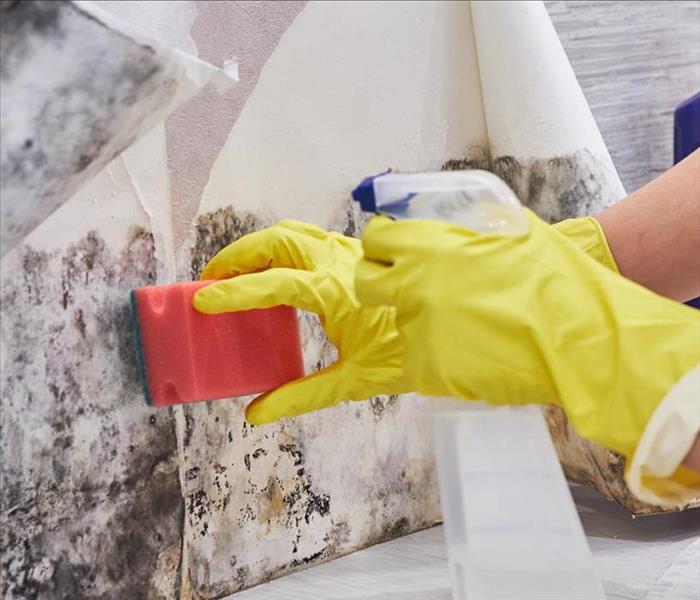 Mold thrives in places with excess moisture.
Mold thrives in places with excess moisture.
If you have black mold or other fungus growing in your house, you may be wondering why. The short answer is that mold tends to grow in environments that are most conducive to it. Identifying the conditions in your home that make it a good place for mold to thrive and eliminating them is the key to preventing future fungus problems.
3 Conditions That Make Mold Thrive
1. Excess Moisture
Mold grows best in damp conditions. This is why it is commonly found in places that normally have a lot of moisture, such as bathrooms, kitchens, laundry rooms and crawl spaces. A moisture problem from a leaking pipe, roof leak, flood or storm damage can create ideal conditions for mold growth in your home. If you have mold, one of the first steps to take is to look for water damage and repair the issue that caused it.
2. Food Sources
In addition to water, black mold and other fungi need a food source to survive. Indoors, mold tends to feed off of organic materials such as the wood in your moldings, wallboards and ceiling and dust and dirt on surfaces. Because it is nearly impossible to eliminate all the food sources, it is usually more productive to focus on reducing moisture.
3. Lack of Sunlight
Direct sunlight can kill the mold; however, indoor lighting does not have the same effect. Despite that, mold still prefers to grow in dark places, so it is particularly important to avoid damp conditions in the parts of your home that are also dimly lit. A mold cleanup specialist in Washington, NC, can help you identify the areas of your home where mold is most likely to be a problem.
Black mold and other fungi grow in places where the conditions are most conducive. Because moisture is the element most under your control, eliminating excess moisture in your home is one of the best ways to combat mold.
Mold Coverage for Your Home
1/26/2021 (Permalink)
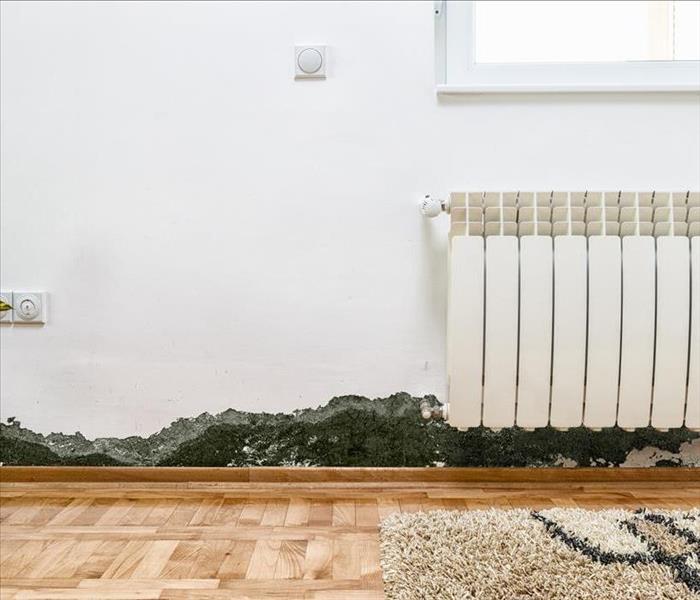 Mold damage
Mold damage
Your homeowners insurance is designed to protect you from having to pay out of pocket for sudden disasters that occur in your home in Washington, NC. The busted pipe and subsequent water damage from a few weeks ago may have been resolved, but the telltale odor and the positive mold test indicate that you haven't reached the end of that story yet. Does your policy cover the cleanup?
Residential Mold Coverage
Typical Coverage
Most basic policies only cover the services of mold mitigation experts if the growth was the direct result of a covered peril. There are many examples of circumstances in which this can occur:
- Roof leak that causes growth before it can be fixed
- Sink that leaks into the cabinet below where mold can thrive
- Supply line rupture behind refrigerator that causes mold damage to the wall behind it
Some policies even have clauses that detail partial mold coverage. For example, they may pay for the cleanup services but not for the mold test or restoration. The policy you've chosen may cover mold but only up to a certain dollar amount. Your agent can clarify exactly what your policy covers if you discover a mold problem in your home.
Additional Coverage
Some homeowners find it prudent to purchase additional mold insurance. This is a particularly smart move if you live in a very humid area where mold issues are more prevalent. If you own an older home, it may have been built with materials that are naturally more prone to fungus growth. In this case, extra coverage or a mold endorsement may be worth considering. Getting this additional protection may cost several hundred dollars more a year, but if you end up needing to file a claim, it can save you a lot of money, too.
If a mold test reveals that you need remediation, your insurance policy may not cover the whole cost. It's important to know how well your current policy covers the repairs you need.
Features of Good Air Purifiers
11/19/2020 (Permalink)
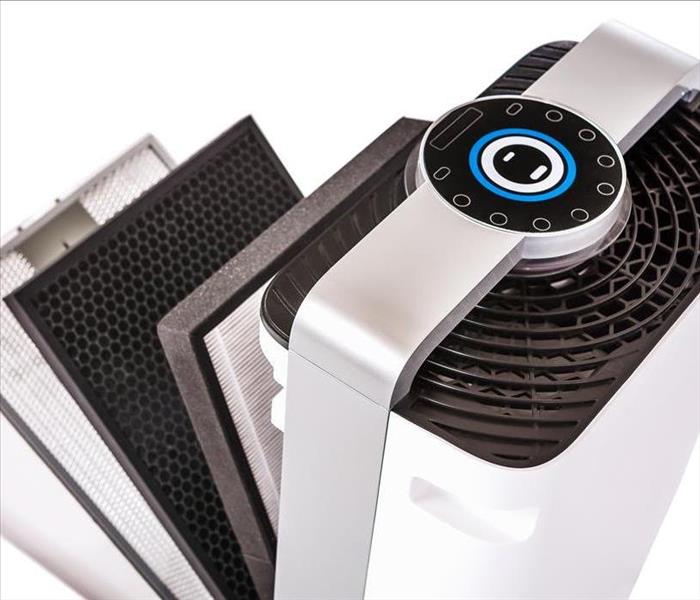 Air purifiers can be effective in avoiding future problems.
Air purifiers can be effective in avoiding future problems.
There are many things you can do to prevent mold growth in your home in Washington, NC, such as controlling moisture and maintaining steady air flow. Another tactic you can try is using an air filtration system to remove some mold spores from the air before they have a chance to settle and multiply. Not all devices are the same, though, so it's vital to know the features you need to seek to find one that is effective against mold.
2 Features of Air Purifiers
HEPA Filter
The main job of an air purifier is to remove impurities from the space around it, leaving behind fresher, cleaner air. A HEPA filter is designed to remove very small particles:
To be classified a True HEPA filter according to Department of Energy standards, it must trap 99.97% of the particles that are 0.3 microns. When shopping for an air filtration device, don't settle for a HEPA-like filter. A HEPA filter may cost more, but its performance will likely make it worth the extra money.
Activated Carbon Filter
Another problem that often comes with mold is the musty odor. Once you have a growth in your home, it may take a while for the smell to dissipate even after mold mitigation specialists have finished the cleanup process. Even the best HEPA filter you can buy doesn't get rid of musty smells. The gases that cause the lingering stench in your home are too small for it to capture. A purifier with an activated carbon filter, however, traps odors from the area around it by absorbing the gases into the filter itself. If you want to remove not only the particles causing the odor but the gases they leave behind, you need a purifier with this feature.
When it comes to mold prevention, cleaning up existing growth is only half the battle. An air filtration system that lowers the concentration of spores in your home can be effective in avoiding future problems.
Mold Remediation Process explained.
8/7/2020 (Permalink)
1: Contact SERVPRO of Bath (252) 923-0213
The mold cleanup and restoration process will begin when you call our office. Our office will ask a series of different questions to help us decide the right equipment, resources, and personnel best fit for you.
2: Inspection
SERVPRO of Bath will carefully inspect your residence or commercial business for visible signs of mold.
3: Mold Containment
SERVPRO professionals use diverse containment methods to prevent the spread of mold. They may use modern containment procedures such as, negative air chambers to separate the contaminated area with physical barriers and negative air pressure to keep the mold spores from spreading during the cleanup operation. All fans and heating and cooling systems will need to be turned off to stop the spread of mold.
4: Air Filtration
Our unique filtration equipment allows our technicians to catch microscopic mold spores out of the air. We use powerful air scrubbers and HEPA vacuums to prevent the spread of these mold spores while the mold remediation is in process.
5: Removing Mold
The mold remediation process depends on the amount of mold growth and the types of surfaces on which the mold appears. Our techs use antifungal and antimicrobial treatments to remove mold colonies and to help put a stop to new colonies from reestablishing. Removing and discarding of mold-infested porous materials, like drywall and carpeting, may be necessary to remediate hefty mold growth.
6: Cleaning Contents
SERVPRO will clean all your belongings that have been affected by mold. We use a variation of cleaning techniques to clean and sanitize your possessions. We are also trained to remove odors using fogging equipment.
7: Restoration
Depending on the level of mold damage, building materials may be removed. Restoration may involve minor repairs, for instance, replacing drywall, painting, and installing new carpet; or it may entail major repairs such as the reconstruction of various areas or rooms in a business or home.
Tips for Mold Damage
8/7/2020 (Permalink)
48 hours. That’s how quickly mold can become a problem in your business or home when there’s an invasion of water, like a broken/leaky water line, or a roof leak. Mold can cause damage not only to your property but to your health as well. SERVPRO of Bath has the specialized equipment necessary and expert training to handle your mold problem.
If you have a mold problem in your home or business, review the facts listed below:
- Children, the elderly, and anyone with respiratory problems are at greater risk with mold and health problems.
- A strong, musty odor could possibly mean there is hidden mold under carpet or behind drywall.
- Outstanding mold growth can occur in 48-72 hours.
What you should do:
- Contact SERVPRO of Bath for mold estimates and remediation services.
- Stay away from mold affected areas.
- Turn off all HVAC system and fans.
Have a Mold Problem?
Call SERVPRO of Bath- (252) 923-0213
Even the smallest amount of water can lead to mold growth
6/23/2020 (Permalink)
A small leak in your Bath, NC home can lead to mold
You had a small water leak, no big deal, you cleaned it up yourself. Everything looks dried out and the problem is solved. But now, a little time later, you see mold. If you see visible mold, your best move is to leave it alone and call professionals. When you disturb mold by trying to remove it, you can inadvertently spread the mold infestation throughout your home. Mold spores are microscopic and when you try to clean them, the mold can release tiny spores which become airborne and can circulate inside your home. Call the professionally trained technicians at SERVPRO of Bath, we’re here to help with your mold mitigation.
What should you do?
- Stay out of affected areas.
- Turn off the HVAC system and fans.
- Contact SERVPRO Bath for mold remediation service immediately, we’re IICRC professionals.
What should you Not to Do:
- Do not touch or disturb any mold you find.
- Do not blow air across any surfaces with visible or suspected mold growth.
- Do not attempt to dry or mitigate the area yourself.
- Do not spray bleach or other disinfectants onto the mold.
About the Mold Remediation Services at SERVPRO of Bath
SERVPRO of Bath specializes in mold cleanup and restoration, in fact, it is one of the cornerstones of our business. Our crews are highly trained restoration professionals that use specialized equipment and techniques to properly remediate your mold problem quickly and safely. We are locally owned and operated. Contact us for services when you first find mold in your home or business.
What Do You Do When Mold is Discovered In Your Apartment?
12/23/2019 (Permalink)
Your landlord has the responsibility to provide you and your family with a clean place to live. While mold is not necessarily dangerous, it is unsettling to look at and, for some people, it can definitely trigger allergy symptoms. There is also the point that mold can cause damage to a building's structure and a person’s belongings that have come in contact with mold. For these reasons and some others, if you discover mold in your apartment you should immediately contact your landlord or property management company. And, then you should contact a reputable company who specializes in mold cleanup. Here are some steps you should take as you discover mold contamination in your apartment:
- As we just noted, contact your landlord.
- Take pictures of the mold infestation and provide them to your landlord or property management company.
- Make yourself available when the mold mitigation company arrives.
- Make sure an air quality test is performed at your apartment to ensure mold spores aren't in other areas of the space.
- Once the tests are performed, the mold remediation company can begin the mold remediation process.
It’s unfortunate, but some landlords may not be as cooperative as they should. If your landlord ignores you or refuses to take responsibility for the mold remediation process, there is a specific way you should handle the situation. Here are some things you can do if your landlord or property management company won’t take action:
- The first thing you need to do is contact an attorney. An attorney can tell you the best way to proceed as well as let you know what your legal rights may be.
- After you contact an attorney, make copies of everything. Make sure you’ve made copies of written notices, photos and any receipts for costs you’ve incurred trying to resolve the mold issue on your own.
- Next, call a company and schedule an indoor air-quality test. You will need these results to prove that the conditions in your apartment or home are a threat to you and your families’ health.
- Lastly, if necessary, file a lawsuit. If you do this and win, you may receive some type of settlement for your damages which could include reimbursement for your attorney fees and any tests or remediation services you’ve paid for, a reduction in rent and possibly other costs determined by the court.
If you have signs of mold in your apartment or rental property, your landlord is the responsible party for mold cleanup. He or she should contact a professional mold remediation company such as SERVPRO of Bath.
Nontoxic Ways to Kill Mold
11/22/2019 (Permalink)
Mold is common and grows rapidly in places that are dark and damp. Sometimes you might not even know you have mold in your home for a long time. The most common places you’ll find mold are in your basement, kitchen, and bathroom, or any other room that encounters water. It can take anywhere from 24 hours to 2 days for mold to grow. You should always watch out for mold and eliminate all mold at first sight. To remove the mold all you need are some common household supplies. Here are 3 easy and effective solutions for killing mold in your home.
Hydrogen Peroxide
Hydrogen peroxide can be used for many different things. It is a chemical used to prevent infections on the skin from cuts and burns. It can fight fungi, help treat viral and bacterial infections on the skin, and it can kill mold on kitchen appliances, floors, and walls. To use this method to kill mold, first, pour a solution of hydrogen peroxide with a concentration of 3% into a spray bottle. Then, spray whatever the mold has infested until it is completely saturated. You need to leave the solution on for about 10 minutes. Once the 10 minutes are up, use a brush or a scraper to remove the mold and surrounding moldy stains. Finally, use a rag to wipe off any leftover mold on the surface.
Vinegar
Vinegar is a common household item, and besides its health benefits, it is also a great mold killer. Vinegar has the strength to kill 82% of mold species. Likewise, baking soda in a combination with vinegar is good for terminating other mold species. For mold treatment, pour white distilled vinegar into a spray bottle. Don’t pour water into the spray bottle because the vinegar doesn’t need to be diluted. In order to kill the mold, spray the vinegar onto the moldy surface, then wait for 1 hour. After the hour is up, wipe down the treated surface and let it dry. It will take a few hours for the smell of vinegar to go away.
Baking Soda
Baking soda is obviously most commonly used for baking. However, it does have other household uses and health advantages. It can treat heartburn and it can even be used as a toothpaste for whiter teeth. Also, it can kill household mold and absorb moisture to avoid future mold build up. To abolish mold with this method, you will need a spray bottle, water and ¼ tablespoon of baking soda. First, pour water and then the baking soda into a spray bottle. Then, shake the bottle until the baking soda disperses into the water. Spray the mold with the baking soda solution. Use a scrub brush to scrape the mold off the infested surface. Once you’ve done that, clean the surface with water to remove any more mold excess. To ensure the mold doesn’t grow back, spay the area again with the mixture and don’t wipe it down. Leaving the mixture on the moldy surface will prevent it from coming back in the future.
These methods will help rid mold in your home without the toxic chemicals. These nontoxic substitutes don’t cause any health side effects and are safe for you, your family and the environment.
Signs You Might Have Carpet Mold
8/23/2019 (Permalink)
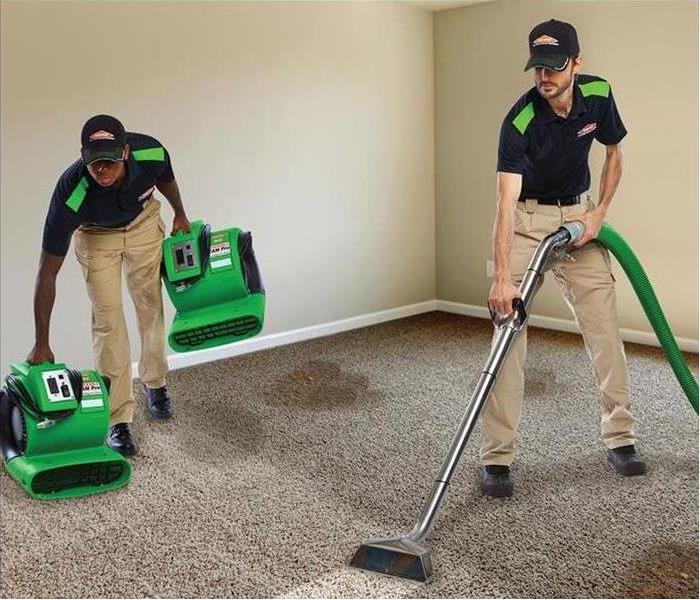 Don't let carpet mold take control of your home or office, call SERVPRO.
Don't let carpet mold take control of your home or office, call SERVPRO.
Mold is extremely invasive and can cause health effects for those living or working in an environment that contains mold. Make sure when liquids are spilled, no matter how small, you clean up properly, and check over time to see if mold has grown within the area. Mold thrives in dark, damp places and underneath your carpet is no exception. Not sure if you have mold in your home? Read the list below to learn the main signs of mold growth!
Do you have musty odors that are smelling throughout your home or business?
This a sure-fire way to know if you have mold in your home! However, if you spend a lot of time in your home it can be hard to detect a musty odor. Pay close attention to how your visitors react when they step into your home and take note if they mention a musty smell.
Does your space have a damp carpet?
Any floor that remains damp for more than 24 hours could begin to grow mold. If you notice that your carpet has become damp, the most common cause is a leak from underneath typically in your basement. If your basement has leaking pipes, there is a high chance that your nearby carpet has mold growth.
Have you looked under your carpet for mold?
Stay on top of mold growth by continually checking underneath your carpet for mold growth. Once you lift your carpet, thoroughly look for discolored flooring/patches, and any musty odors.
Do you see white, green, or black spots that have appeared that were not there before?
If you see these spots on your carpet, then your mold growth has reached an advanced stage. These color patches are caused by the mold growth multiplying onto your carpet.
Have you tested your carpet for mold with a mold test?
There are mold-testing kits available for you to test the airflow across your carpet. If there is mold in your home then the mold spores will land on your testing kit and begin to multiply. SERVPRO of Bath offers an exclusive guarantee with our mold testing services. Reach out to us today to learn more!
These are MAIN signs that you have mold growing under your carpet! Mold can be extremely difficult to eliminate once it begins to grow. Contact us today for mold testing in your home!
Mold Prevention Tips
8/8/2019 (Permalink)
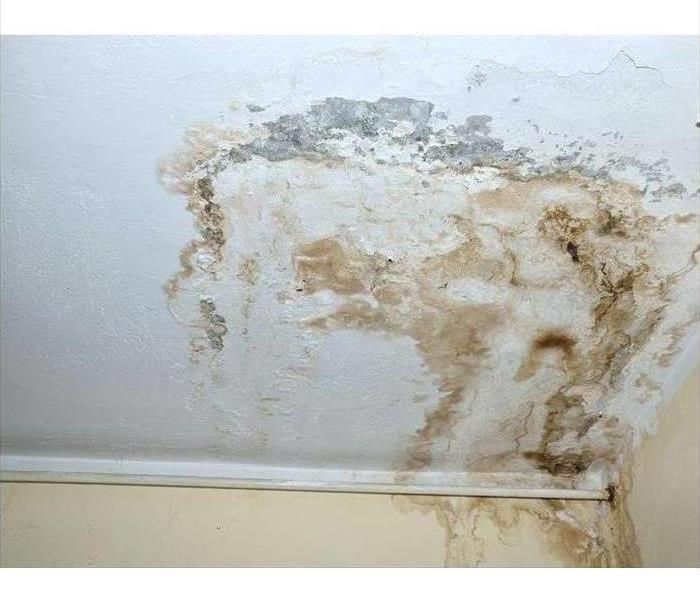 This ceiling has been affected by mold.
This ceiling has been affected by mold.
Mold is a common household problem, developing in warm, damp environments. Mold can be colored green, purple, white, and orange. While mold plays an important role outside in the environment, breaking down dead plants, mold is unwelcome in homes.
Showers and bathrooms are a common location for mold to grow, but mold can grow anywhere in a home. Mold can come inside a home from an outside growth through inadequately sealed windows or doors. Mold spores cannot be eliminated, but they will not grow if the environment is dry and well ventilated. Mold growth can be prevented by ensuring if water damage occurs, clean up occurs quickly. Using air conditioners during humid seasons and exhaust fans in the kitchen can help prevent mold from growing.
Other areas to monitor moisture to prevent mold growth: exterior walls and surfaces in need of insulation where condensation can build, air conditioner drip pans, check for leaks around the refrigerator, ensure crawl spaces are well ventilated and check for leaks around a tub.
These are a few simple tips for making sure mold is not growing in your home. If you do discover mold growth, SERVPRO of Bath provides mold remediation services for all types of residential and commercial properties. Are you worried there might be too much mold in your home? Contact us today for our new mold testing!
MOLD – Just follow your Nose!
2/5/2019 (Permalink)
SERVPRO of Bath recently held a Continuing Education Class for Realtors on Mold. SERVPRO offers these Continuing Ed classes to both Insurance and Realtor Professionals Free of Charge. Realtors from Roanoke Rapids, Lake Gaston, Virginia and surrounding areas gained knowledge on the contributing factors, dangers and remedies for mold and fungus. SERVPRO Franchise owner and class instructor, Cindy Baldwin emphasized that first it is important to remove the moisture source, make sure the area is completely dry and afterwards a thorough cleaning is in order. She also warned of the importance of wearing a mask that can filter both fine particles and gas as well as other proper protective equipment. She explained the biggest indicator of mold is your nose since mold can grow anywhere there is moisture and leaves a musty, bad smell. Cindy explained there are thousands of kinds of molds and those molds are a part of every environment.
Cindy, along with her husband John Baldwin, also part owner of the Franchise, gave suggestions homeowners can do to prevent mold from getting out of hand included keeping crawlspace vents open year-round and making sure attics have proper ventilation. Since airflow is extremely important, Cindy also said to make sure dryer vents are properly attached and that the air flows to the outside of the house, not under it.
As the class concluded, John and Cindy both demonstrated and discussed the process, equipment and treatments SERVPRO uses for mold remediation. Feedback from class participants was very positive and indicating they look forward to future classes.
Conditions In Our Area Are Prone to Mold
5/8/2018 (Permalink)
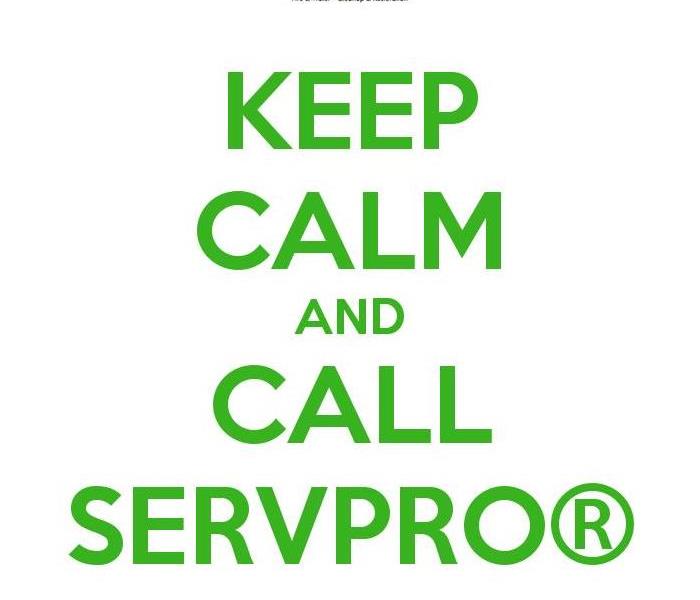 SERVPRO of Bath knows what to do if mold grows in your home
SERVPRO of Bath knows what to do if mold grows in your home
More than a million types of mold exist, yet less than 10 percent have actually been named. This means mold is very common in both indoor and outdoor environments. While mold and humans can sometimes co-exist without issue, there are certain species of mold that can cause health effects for some people.
If the right conditions exist, mold will grow. Those conditions include:
- Water - Different mold types require varying amounts of liquid before growth begins.
- Temperature - Normal indoor temperatures will promote mold growth.
- Time - Initial mold colonizers can take hold within one day after being exposed to an adequate water supply.
Since mold growth can occur in any home, watch for situations that promote mold activity.
Roof/chimney leaks, wet basements, or condensation from ducts that dampen surrounding insulation are just a few examples. Wind driven rain is a common source of mold growth around your window. A dark circle appearing on your ceiling especially when a bathroom is above is a cause of concern Check your caulking around all sinks and tubs.
If you suspect mold in your home, call SERVPRO of Bath to assess the situation. We have the knowledge, tools and track record to effectively remediate mold in your home or business.
If you suspect mold, call us today at 252.923.4357
What to Do:
- Stay out of affected areas.
- Turn off the HVAC system and fans in that area if possible.
- Contact SERVPRO of Bath for mold remediation services. 252-923-0213
Quick Tips on Mold
5/8/2018 (Permalink)
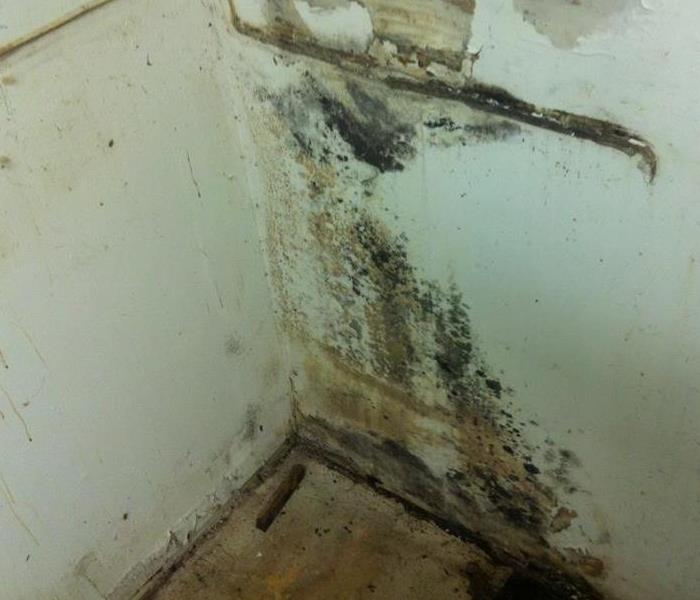 Call SERVPRO of Bath for a mold problem in your home.
Call SERVPRO of Bath for a mold problem in your home.
When spring arrives so will the rainy season. Rain can bring the opportunity for mold growth to present itself in your home. Call SERVPRO of Bath at the first sight of any moisture or growth. If you discover mold in your home or office, we are here to help.
Mold and fungal spores occur naturally outdoors, where fungi are the earth’s natural recyclers. Indoor, mold needs moisture to grow. Problems occur when trapped moisture, humidity, and dampness are present.
Common ways for excessive moisture that can lead to mold can include:
- Damp crawl spaces
- Flooding from surface water (storms, flooded streets, etc.)
- Roof leaks
- Leaking pipes
- Poor caulking around windows, bathtubs, sinks
- Lack of air flow when air conditioning or fans are shut off
- Sewer back ups
How to prevent mold growth:
- Control excessive moisture and condensation
- Keeping susceptible areas in your home clean and dryIn the case of leaking pipes or a flood, standing water needs to be taken care of immediately. When materials are wet they should be clean, removed, replaced or dried out. Items that are wet for longer than 48 hours or more may grow mold. If properly remediated, damage will less and costs will be lower.
SERVPRO of Bath will first isolate the area that has mold preventing further contamination within your home or business. Then proper vacuuming will occur with HEPA vacuums and then areas will most likely be removed and apply negative air flow to remove particles from the area.
Call SERVPRO of Bath at
252-923-0213 to help you.
Follow Mold Safety Tips If you Suspect Mold
5/7/2018 (Permalink)
 Be careful! Without proper training, you could be spreading mold throughout your home.
Be careful! Without proper training, you could be spreading mold throughout your home.
If you see visible mold, do not disturb it. You can inadvertently spread the mold infestation throughout your home. When mold is disturbed, the mold can release microscopic mold spores which become airborne and can circulate inside your home.
What to Do:
- Stay out of affected areas.
- Turn off the HVAC system and fans in the affected areas if possible.
- Contact SERVPRO of Bath for mold remediation services.
What Not to Do:
- Do nottouch or disturb the mold.
- Do not blow air across any surfaces with visible or suspected mold growth.
- Do not attempt to dry the area yourself without containing the spread of mold.
- Do not spray bleach or other disinfectants that are not approved for the elimination of mold as they usually do not kill the roots or stop the spores from spreading.
About Our Mold Remediation Services
SERVPRO of Bath specializes in mold cleanup and restoration, in fact, it’s a cornerstone of our business. Our crews are highly trained restoration professionals that use specialized equipment and techniques to properly remediate your mold problem quickly and safely.
If You See Signs of Mold, Call Us Today – 252.923.0213
Does Your Bath Home Have A Mold Problem?
5/1/2018 (Permalink)
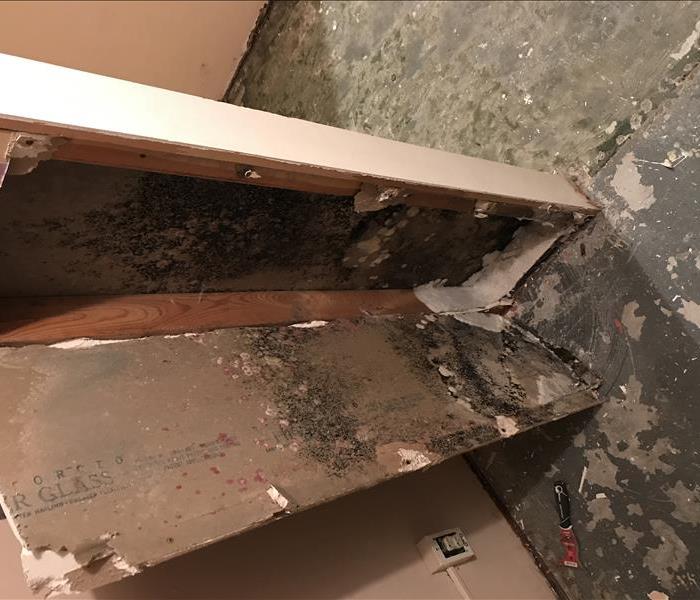 One of our clients had a mold problem and called us right away. Call SERVPRO of Bath today if you believe you have a mold problem in your home.
One of our clients had a mold problem and called us right away. Call SERVPRO of Bath today if you believe you have a mold problem in your home.
Microscopic mold spores naturally occur almost everywhere, both outdoors and indoors. This makes it impossible to remove all mold from a home or business. Therefore, mold remediation reduces the mold spore count back to its natural or baseline level. Some restoration businesses advertise “mold removal” and even guarantee to remove all mold, which is a false statement. Think about the following mold facts:
- Mold is present almost everywhere, indoors and outdoors.
- Mold spores are microscopic and float along in the air and may enter your home through windows, doors, or AC/heating systems or even hitch a ride indoors on your clothing or a pet.
- Mold spores thrive on moisture. Mold spores can quickly grow into colonies when exposed to water. These colonies may produce allergens and irritants.
- Before mold remediation can begin, any sources of water or moisture must be addressed. Otherwise, the mold may return.
- Mold often produces a strong, musty odor and can lead you to possible mold problem areas.
- Even higher-than-normal indoor humidity can support mold growth. Keep indoor humidity below 45 percent.
If your home or business has a mold problem, we can inspect and assess your property and use our training, equipment, and knowledge to remediate your mold issue.
If You See Signs of Mold, Call Us Today –(252) 923-0213
When is mold really mold?
1/24/2018 (Permalink)
 Mold on a picture frame,
Mold on a picture frame,
We often get calls from folks that think they have mold in their homes, asking us for an estimate to remediate or clean the area. In some cases, it may not necessary, because, what the home owner is actually seeing is either, remains of insects from getting in your home or wear and tear stains.
It looks just like mold but it's not. How can you tell?
Try rubbing the surface with your finger to determine if the spot is hard or soft and dusty. If it's hard, it's probably not mold.... If you are still not certain, give us call for some advice on what to do.
There's no sense spending money if you do not have to...Call us today with any mold questions!
What to do if you find mold
8/21/2015 (Permalink)
Recently we worked with a homeowner who lost the sale of his home when the inspector found a large amount of mold in his crawl space. This was caused by the excessive moisture due to improper ventilation.
SERVPRO of Bath was able to remove the mold and correct the rotting wood all within 72 hours from first call. A previous contractor informed him he would have to rip out his floor in the sunken living room space. All that was necessary was to increase ventilation in the crawlspace after clean up and replacement of a joist.
Now our customer can put his house back on the market while we are still in the height of the selling season.
Call SERVPRO of Bath at 252-923-0213 anytime day or night. We are always here to help.






 24/7 Emergency Service
24/7 Emergency Service










